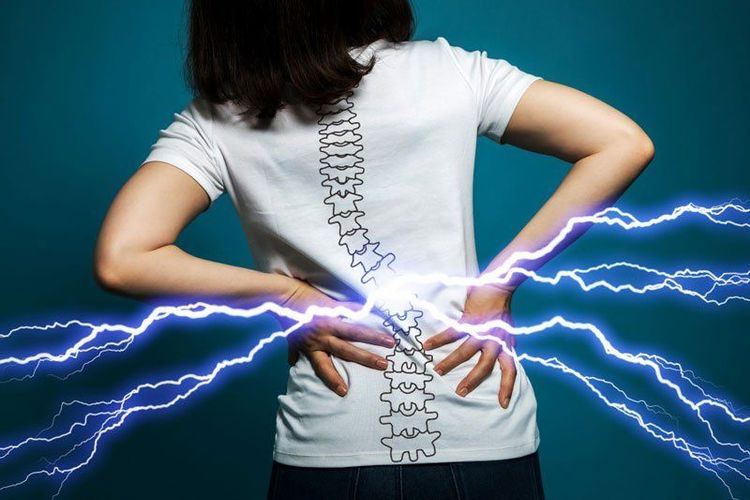This is an automatically translated article.
The detection of acute renal infarction is often delayed or missed because of the rarity of the disease and its nonspecific clinical presentation. Sudden onset of low back pain in patients at high risk for thromboembolism may be the first sign of renal infarction. Only when thinking about acute renal infarction, the patient has the opportunity to be diagnosed and treated promptly, saving the damaged kidney.1. Recognizing low back pain due to acute renal infarction
Lower back pain is a common problem and can account for up to 15% of all new outpatient visits. In the majority of cases, low back pain is usually a benign condition related to posture or physical stress, which usually resolves on its own or is easily treated.Therefore, low back pain is often not recognized as a symptom of serious illness. Meanwhile, there are some cases of acute renal infarction with sudden onset of low back pain.
When retrospectively exploited on patients with acute renal infarction, persistent low back, abdominal and flank pain also accounted for a certain proportion. However, the initial assessment often points to other more common diseases such as spondylolisthesis, gastrointestinal diseases, urinary stones or even myocardial infarction.
On the other hand, in the retrospectively observed subjects, either the existing or preclinical risk factors indicated were absent or the sensitivity and specificity were very low for the diagnosis of acute renal infarction. count . In other words, the attending physician needs to have minimal awareness of this diagnosis in order to provide appropriate management, including performing examinations, ordering tests, and including immediate intervention. to preserve kidney function.

đau thắt lưng thấp có thể là dấu hiệu của nhồi máu thận cấp tính
2. Approach to diagnosis of acute renal infarction with initial symptom of low back pain
Clinical examination Patients with acute renal infarction may be hospitalized with abdominal pain, flank pain, and rarely, persistent low back pain. However, the diagnosis of acute renal infarction is often delayed or missed, because the condition is rare and the clinical presentation is nonspecific. Most patients have at least one documented history of high thromboembolic risk, including atrial fibrillation, prior embolism, and valvular or ischemic disease as risk factors. major risk factor for acute renal failure.These risk factors are often recognized early or are already present in the medical history or physical examination. However, other causes of acute renal infarction have also been associated with rare conditions, including trauma, acquired and inherited clotting disorders, cocaine use, and vascular malformations such as fibromuscular dysplasia. or genetic diseases such as Marfan syndrome or Ehlers Danlos syndrome, medical interventions such as valve replacement surgery, kidney transplantation, endovascular catheterization and stenting, malignancy...
Indications For Testing In In cases where the clinical diagnosis of acute renal failure is uncertain due to atypical findings and no risk factors for thromboembolism, supportive laboratory studies should be established. Laboratory findings such as hematuria and elevated LDH should suggest this diagnosis. In particular, dipstick urinalysis is a simple screening test for many general kidney diseases. The sensitivity of this test for hematuria is high in contrast to its low specificity because of cross-reactivity in the presence of myoglobinuria. Therefore, repeat urinalysis within the first 24 hours of pain onset should be performed to increase diagnostic value.
Besides, quantification of serum LDH levels in the blood as a hallmark of cell necrosis is elevated in patients with acute renal infarction. Since serum LDH is sensitive but nonspecific, other causes of LDH elevation, such as acute myocardial infarction, tumor, mesenteric embolism, etc. must also be ruled out as soon as possible.
Renal-specific facilities such as angiography, renal scintigraphy, venous radiographs, renal ultrasound and computed tomography can be of value in diagnosing acute renal infarction. In which, contrast-enhanced computed tomography is the non-invasive reference standard to diagnose acute renal infarction quickly, showing that the infarction area is not enhanced after contrast injection. Although ultrasonography still has a role to rule out urolithiasis, it lacks sensitivity for early detection of acute renal infarction. Selective renal angiography is an invasive diagnosis but has the limitation of being difficult to do at baseline.
Treatment Specific guidelines for acute renal artery embolism do not have formal recommendations.
However, in all cases, prompt recognition of acute renal infarction is important. At this time, fibrinolytic or anticoagulant therapy will be considered and indicated on a case-by-case basis, considering the duration of the medical history, the benefits achieved and the possible risks, especially hemorrhagic complications due to antithrombotic drugs in general.

Bệnh nhân bị nhồi máu thận cấp tính có thể nhập viện bởi đau bụng
When noticing symptoms of low back pain, the patient should pay attention and go to the doctor for an accurate diagnosis and prevent serious risks. Currently, Vinmec International General Hospital is one of the leading prestigious hospitals in the country, trusted by a large number of patients for medical examination and treatment. Not only the physical system, modern equipment: 6 ultrasound rooms, 4 DR X-ray rooms (1 full-axis machine, 1 light machine, 1 synthesizer and 1 mammography machine) , 2 DR mobile x-ray machines, 2 multi-row CT scanner rooms (1 128 arrays and 1 16 arrays), 2 Magnetic Resonance imaging rooms (1 3 Tesla and 1 1.5 Tesla), 1 room for 2 level interventional angiography and 1 room for bone mineral density.... Vinmec is also the place to gather a team of experienced doctors and nurses who will greatly assist in the diagnosis and detection. early signs of abnormality of the patient's body. In particular, with a space designed according to 5-star hotel standards, Vinmec ensures to bring patients the most comfort, friendliness and peace of mind.
Please dial HOTLINE for more information or register for an appointment HERE. Download MyVinmec app to make appointments faster and to manage your bookings easily.













